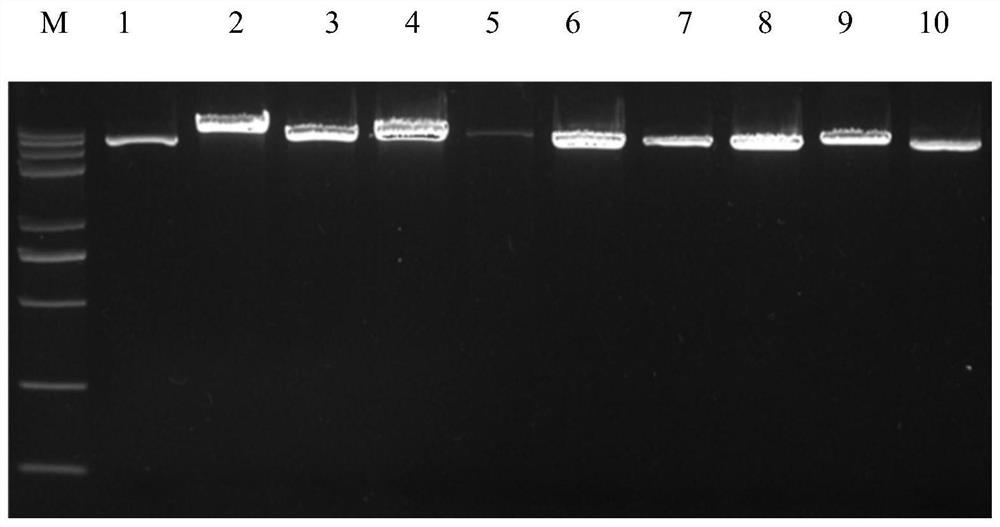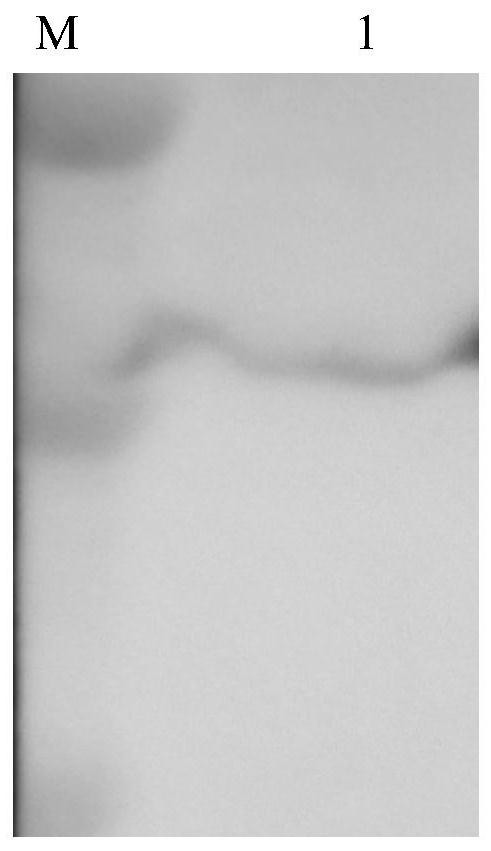A method for in vitro construction of silkworm plasmopolyhedrosis virus based on dna vector
A technology of plastid polyhedrosis and construction method, which is applied to the field of in vitro construction of silkworm plastid polyhedrosis virus, can solve problems such as difficulty in obtaining sequence comparison, affecting virus efficiency, and easy degradation of RNA molecules.
- Summary
- Abstract
- Description
- Claims
- Application Information
AI Technical Summary
Problems solved by technology
Method used
Image
Examples
Embodiment 1
[0065] Example 1: In vitro construction and characteristic detection of silkworm plasmopolyhedrosis virus
[0066] 1. In vitro construction of virus:
[0067] (1) Extract the silkworm plasmopolyhedrosis virus genome:
[0068] Collect the midgut tissue of silkworm diseased polyhedrosis silkworm, add double distilled water according to the ratio of 1g midgut tissue: 10mL double distilled water (self-made, Chengdu Ultrapure Technology Co., Ltd., UPT-Ⅲ-5T ultrapure water machine) , after homogenization, filter with gauze, and the filtrate is centrifuged at a differential speed by a CF15D2 centrifuge (KuBoTa Company, Japan) to obtain pure silkworm plastid polyhedron; add water to suspend the pure silkworm plastid polyhedron, and adjust the concentration to per mL of water Contains at least 10 8 Polyhedron; Take 0.5mL of polyhedron suspension, add an equal volume of Tris-balanced phenol (Beijing Suo Laibao Technology Co., Ltd.), shake the mixture on a QL-901 oscillator (Qilin Beie...
Embodiment 2
[0130] Example 2: In vitro construction of silkworm plasmopolyhedrosis virus.
[0131] 1. According to the RNA sequence of S1 to S10 fragments, the cDNA of S1 to S10 is fully chemically synthesized;
[0132] 2. Construction of recombinant plasmids:
[0133] Take the cDNAs from S1 to S10 fully chemically synthesized in step (1), and clone them into the pIZT-V5 / His vector respectively, wherein:
[0134] The full-length cDNA of the S1 fragment was cloned into the SacI and SacII sites of pIZT-V5 / His;
[0135] The full-length cDNA of the S2 fragment was cloned into the SacI and SacII sites of pIZT-V5 / His;
[0136] The full-length cDNA of the S3 fragment was cloned into the SacI and SacII sites of pIZT-V5 / His;
[0137] The full-length cDNA of the S4 fragment was cloned into the kpnI and SacII sites of pIZT-V5 / His;
[0138] The full-length cDNA of the S5 fragment was cloned into the kpnI and SacII sites of pIZT-V5 / His;
[0139] The full-length cDNA of the S6 fragment was cloned ...
Embodiment 3
[0149] Embodiment three: In vitro construction of silkworm plasmopolyhedrosis virus
[0150] (1) Same as the step (1) in the in vitro construction of the virus in Example 1;
[0151] (2) The genome of silkworm plasmopolyhedrosis virus was separated by 0.75% agarose gel electrophoresis, and the results were as follows: Figure 5 As shown, from bottom to top, each nucleic acid band is the S1 to S10 fragments, respectively. Use the nucleic acid gel recovery kit to recover the RNA of each fragment, and use it in RNase-free double distilled water to obtain the RNA from S1 to S10 respectively;
[0152] (3) Take 20 μL of RNA from S1 to S10 in step (2), boil at 100°C for 10 minutes, then ice-bath for 2 minutes, take 1 μL as a template, and use the RNA in step (2) in the in vitro construction of the virus in Example 1 Primers PS1R, PS2R, PS3R, PS4R, PS5R, PS6R, PS7R, PS8R, PS9R, and PS10R were reverse-transcribed using a reverse transcription kit (Transcriptor Reverse Transcriptase, ...
PUM
 Login to View More
Login to View More Abstract
Description
Claims
Application Information
 Login to View More
Login to View More - R&D
- Intellectual Property
- Life Sciences
- Materials
- Tech Scout
- Unparalleled Data Quality
- Higher Quality Content
- 60% Fewer Hallucinations
Browse by: Latest US Patents, China's latest patents, Technical Efficacy Thesaurus, Application Domain, Technology Topic, Popular Technical Reports.
© 2025 PatSnap. All rights reserved.Legal|Privacy policy|Modern Slavery Act Transparency Statement|Sitemap|About US| Contact US: help@patsnap.com



